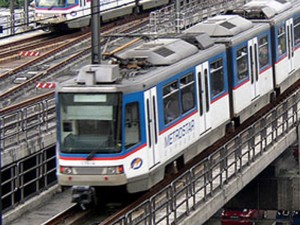MANILA, Philippines — A long-overdue fare increase at Metro Manila’s three elevated railways could take effect as early as August this year as the government seeks to recover part of its operating costs from the heavily subsidized train lines, according to Transportation and Communication Secretary Joseph Abaya.
But Abaya said at a roundtable discussion with the Philippine Daily Inquirer on Wednesday that the planned P10 average increase for the Light Rail Transit (LRT) Lines 1 and 2 and the Metro Rail Transit (MRT) Line 3 will be done in two equal parts through 2014.
This means fares, which were last adjusted in the early 2000s, will increase by P5 in 2013 while the second P5-increase will kick in next year.
“This increase has been long-delayed so we are about to execute it. The matrix for LRT 1 requires us to catch up,” Abaya said. “It was discussed a year ago in the budget hearing and it was taken as a set, all three railway lines.”
“It should happen planning-wise in August or within the year,” Abaya added.
Reports showed earlier that the entire P10 average fare hike will happen this year but Abaya said the department decided to “break it up” into two parts over two years.
Even with the fare increase, the LRT lines and MRT 3 come out “cheaper” than the rates charged by bus operators, which are pegged at P40 per passenger, Abaya said.
The government is calculating that ridership on the three train lines, which serve over 1.3 million passengers daily, will not be substantially affected by the rate increase.
The current fare on the MRT, which runs through Edsa (Epifanio Delos Santos Avenue), Metro Manila’s main highway, is pegged at a maximum of P15 per passenger. For LRT1, passengers are charged up to P20 each for a single journey; for LRT 2, the rate is pegged at P15 each.
An earlier study by the Light Rail Transit Authority indicated that ridership was initially expected to decline but the study concluded that figures will recover given the “convenience” the train lines offer, a DOTC spokesman said.
The increase, meanwhile, will still need to be cleared with the board of the LRTA, in consultation with Land Transportation Franchising and Regulatory Board.
A public consultation, while not mandated by law, will also be held as this is the typical practice of the agency to allow affected stakeholders to raise their concerns.
Unlike other agencies under the DOTC, the LRTA is unique as it does not have a regulating body when it comes to setting fares.
The government is eyeing a reduction in costly subsidies for the elevated train systems.
For the MRT alone, Abaya said, the government spends P60 to transport one passenger from end to end, well above the current ticket price. This translates to about P7 billion to P9 billion in subsidies every year.
“The motivation is [the railway lines] are even cheaper now than the buses. So from an economic point of view we could stand some [rate] increase and recover some of the operating costs to make sure at least some operating costs are recovered,” Transportation Undersecretary Rene Limcaoco said in a separate interview.
LRT1 is a 20.7-kilometer elevated track that runs from Baclaran, Parañaque to Roosevelt in Quezon City. LRT 2 is a 13.8-km track that starts at Santolan in Pasig City and runs through Claro M. Recto, Manila.
MRT 3 is a 17-km elevated railway that starts at North Avenue in Quezon City and runs through Taft Avenue.


